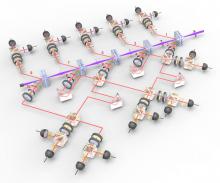Observation of Interference between Resonant and Detuned STIRAP in the Adiabatic Creation of 23Na40K Molecules
Stimulated Raman adiabatic passage (STIRAP) allows efficiently transferring the populations between
wo discrete quantum states and has been used to prepare molecules in their rovibrational ground state. In

